The Ophiolite-Hosted Cu-Zn VMS Deposits of Tuscany (Italy)
Abstract
1. Introduction

2. Geological Background
3. The Tuscan Cu-Zn VMS Deposits
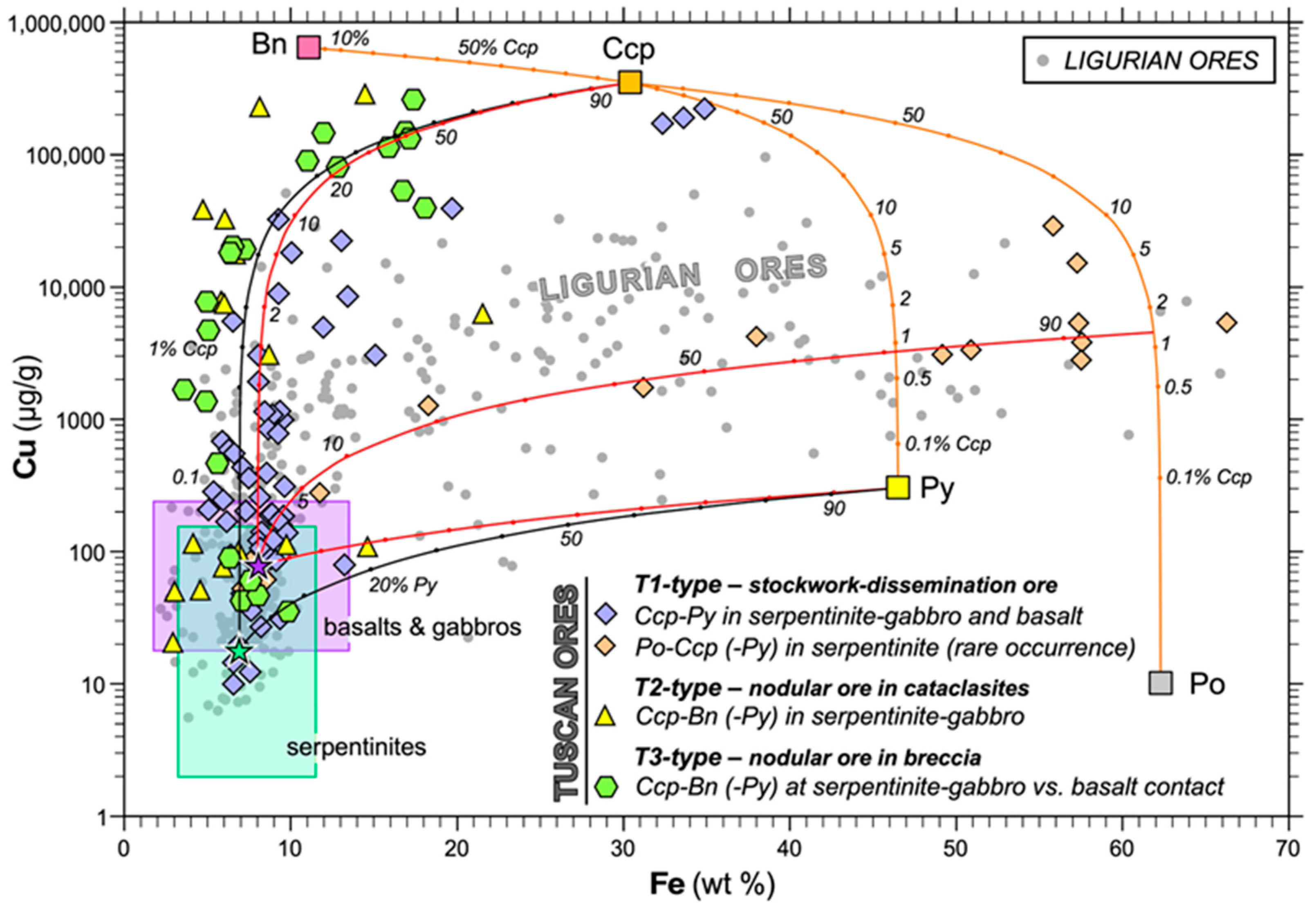
3.1. T1-Type Ore (Stockworks and Disseminations in Serpentinite-Gabbro Basement)
3.1.1. Orebody Geometry and Local Geological Setting
3.1.2. Ore-Gangue Mineralogy and Textures
3.2. T2-Type Ore (Cataclastic Zones in Serpentinite-Gabbro Basement)
3.2.1. Orebody Geometry and Local Geological Setting
3.2.2. Ore-Gangue Mineralogy and Textures
3.3. T3-Type Ore (Breccias at the Serpentinite/Gabbro Basement vs. Pillow Basalt Contact)
3.3.1. Orebody Geometry and Local Geological Setting
3.3.2. Ore-Gangue Mineralogy and Textures
4. Discussion
4.1. The Tuscan VMS Deposits in the Northern Apennine Framework
4.2. The Zoned Sulphide Nodules (T2- and T3-Type Ores)
4.3. Geochemical Signature of Tuscan vs. Ligurian VMS Deposits
4.4. Tuscan VMS and the Architecture of the Jurassic Oceanic Hydrothermal Systems
5. Conclusions
Supplementary Materials
Author Contributions
Funding
Data Availability Statement
Acknowledgments
Conflicts of Interest
References
- Dini, A. Ore deposits, industrial minerals, and geothermal resources. Per. Mineral. 2003, 72, 41–52. [Google Scholar]
- Dini, A.; Gianelli, G.; Puxeddu, M.; Ruggieri, G. Origin and evolution of Pliocene- Pleistocene granites from the Larderello geothermal field (Tuscan Magmatic Province, Italy). Lithos 2005, 81, 1–31. [Google Scholar] [CrossRef]
- Francovich, R.; Dallai, L. Colline Metallifere (Tuscany, Italy): Research and landscape enhancement of a mining district. Archeosciences 2010, 34, 277–287. [Google Scholar] [CrossRef]
- Dini, A.; Boschi, C. I giacimenti cupriferi delle ofioliti toscane. Riv. Mineral. Ital. 2017, 42, 84–101. [Google Scholar]
- Dini, A. I giacimenti minerari della Toscana. In Guide Geologiche Regionali—Toscana, 1st ed.; Conti, P., Conticelli, S., Cornamusini, G., Marroni, M., Eds.; Società Geologica Italiana: Roma, Italy, 2022; pp. 71–77. [Google Scholar]
- Tanelli, G.; Lattanzi, P. Metallogeny and mineral exploration in Tuscany: State of the art. Mem. Della Soc. Geol. Ital. 1986, 31, 299–304. [Google Scholar]
- Westerman, D.S.; Dini, A.; Innocenti, F.; Rocchi, S. Rise and fall of a nested Christmas-tree laccolith complex, Elba Island, Italy. Geol. Soc. Lond. Spec. Publ. 2004, 234, 195–213. [Google Scholar] [CrossRef]
- Vezzoni, S.; Rocchi, S.; Dini, A. Lateral extrusion of a thermally weakened pluton overburden (Campiglia Marittima, Tuscany). Int. J. Earth Sci. 2018, 107, 1343–1355. [Google Scholar] [CrossRef]
- Di Vincenzo, G.; Vezzoni, S.; Dini, A.; Rocchi, S. Timescale of a magmatic-hydrothermal system revealed by 40Ar-39Ar geochronology: The Mio-Pliocene Campiglia Marittima system (Tuscany, Italy). Sci. Rep. 2022, 12, 7128. [Google Scholar] [CrossRef]
- Farina, F.; Dini, A.; Ovtcharova, M.; Davies, J.H.F.L.; Greber, N.D.; Bouvier, A.S.; Baumgartner, L.; Ulianov, A.; Schaltegger, U. Zircon Petrochronology reveals the timescale and mechanism of anatectic magma formation. Earth Planet. Sci. Lett. 2018, 495, 213–223. [Google Scholar] [CrossRef]
- Gola, G.; Bertini, G.; Bonini, M.; Botteghi, S.; Brogi, A.; De Franco, R.; Dini, A.; Donato, A.; Gianelli, G.; Liotta, D.; et al. Data integration and conceptual modelling of the Larderello geothermal area, Italy. Energy Procedia 2017, 125, 300–309. [Google Scholar] [CrossRef]
- Brogi, A.; Liotta, D.; Ruggieri, G.; Capezzuoli, E.; Dini, A.; Meccheri, M. An overview on the characteristics of geothermal carbonate reservoirs in southern Tuscany. Ital. J. Geosci. 2016, 135, 17–29. [Google Scholar] [CrossRef]
- Rimin, S. Mineralizzazioni nelle ofioliti. In Ricerca Mineraria di Base; Italian Ministry of Industry: Roma, Italy, 1990; Volume 17. [Google Scholar]
- Patten, C.G.C.; Coltat, R.; Junge, M.; Peillod, A.; Ulrich, M.; Manatschal, G.; Kolb, J. Ultramafic-hosted volcanogenic massive sulfide deposits: An overlooked sub-class of VMS deposit forming in complex tectonic environments. Earth-Sci. Rev. 2022, 224, 103891. [Google Scholar] [CrossRef]
- Fouquet, Y.; Cambon, P.; Etoubleau, J.; Charlou, J.L.; Ondréas, H.; Barriga, F.J.A.S.; Cherkashov, G.; Semkova, T.; Poroshina, I.; Bohn, M.; et al. Geodiversity of hydrothermal processes along the Mid-Atlantic Ridge and ultramafic-hosted mineralization: A new type of oceanic Cu-Zn-Co-Au volcanogenic massive sulfide deposit. In Diversity of Hydrothermal Systems on Slow Spreading Ridges–Geophysical Monograph Series 188; Rona, P.A., Devey, C.W., Dyment, J., Murton, B.J., Eds.; American Geophysical Union: Washington, DC, USA, 2022; pp. 321–367. [Google Scholar] [CrossRef]
- Rampone, E.; Sanfilippo, A. The heterogeneous Tethyan oceanic lithosphere of the Alpine ophiolites. Elements 2021, 17, 23–28. [Google Scholar] [CrossRef]
- Bonatti, E.; Zerbi, M.; Kay, R.; Rydell, H. Metalliferous deposits from the Apennine ophiolites: Mesozoic equivalents of modern deposits from oceanic spreading centers. Geol. Soc. Am. Bull. 1976, 87, 83–94. [Google Scholar] [CrossRef]
- Zaccarini, F.; Garuti, G. Mineralogy and chemical composition of VMS deposits of northern Apennine ophiolites, Italy: Evidence for the influence of country rock type on ore composition. Mineral. Petrol. 2008, 94, 61–83. [Google Scholar] [CrossRef]
- Conti, P.; Cornamusini, G.; Carmignani, L. An outline of the geology of the Northern Apennines (Italy), with geological map at 1:250,000 scale. Ital. J. Geosci. 2020, 139, 149–194. [Google Scholar] [CrossRef]
- Carminati, E.; Lustrino, M.; Doglioni, C. Geodynamic evolution of the central and western Mediterranean: Tectonics vs. igneous petrology constraints. Tectonophysics 2012, 579, 173–192. [Google Scholar] [CrossRef]
- Elter, P. L’ensemble ligure. Bull. Soc. Géol. Fr. 1975, 17, 984–997. [Google Scholar] [CrossRef]
- Marroni, M.; Meneghini, F.; Pandolfi, L. Anatomy of the Ligure-Piemontese subduction system: Evidence from Late Cretaceous–middle Eocene convergent margin deposits in the Northern Apennines, Italy. Int. Geol. Rev. 2010, 52, 1160–1192. [Google Scholar] [CrossRef]
- Brogi, A.; Liotta, D. Highly extended terrains, lateral segmentation of the substratum, and basin development: The middle-late Miocene Radicondoli Basin (inner Northern Apennines, Italy). Tectonics 2008, 27, TC5002. [Google Scholar] [CrossRef]
- Marroni, M.; Pandolfi, L. The architecture of an incipient oceanic basin: A tentative reconstruction of the Jurassic Liguria-Piemonte basin along the Northern Apennines–Alpine Corsica transect. Int. J. Earth Sci. 2007, 96, 1059–1078. [Google Scholar] [CrossRef]
- Bertini, G.; Cornamusini, G.; Lazzarotto, A.; Maccantelli, M. Stratigraphic and tectonic framework of the Ligurian Units in the Castellina M.ma hills (southern Tuscany, Italy). Boll. Soc. Geol. Ital. 2000, 119, 687–701. [Google Scholar]
- Nirta, G.; Pandeli, E.; Principi, G.; Bertini, G.; Cipriani, N. The Ligurian Units of Southern Tuscany. Boll. Soc. Geol. Ital. 2005, 3, 29–54. [Google Scholar]
- Boschi, C.; Dini, A.; Baneschi, I.; Bedini, F.; Perchiazzi, N.; Cavallo, A. Brucite-driven CO2 uptake in serpentinized dunites (Ligurian Ophiolites, Montecastelli, Tuscany). Lithos 2017, 288–289, 234–281. [Google Scholar] [CrossRef]
- Tribuzio, R.; Thirwall, M.F.; Vannucci, R. Origin of the gabbro–peridotite association from the Northern Apennine ophiolites (Italy). J. Petrol. 2004, 45, 1109–1124. [Google Scholar] [CrossRef]
- Rielli, A.; Boschi, C.; Dini, A. Tectonically driven carbonation of serpentinite by mantle CO2: Genesis of the Castiglioncello magnesite deposit in the Ligurian ophiolite of central Tuscany (Italy). Ore Geol. Rev. 2022, 149, 105022. [Google Scholar] [CrossRef]
- Serri, G.; Hébert, R.; Hékinian, R. Chemistry of ultramafic tectonites and ultramafic to gabbroic cumulates from the major oceanic basins and the Northern Apennines ophiolites. Ofioliti 1985, 10, 63–76. [Google Scholar]
- Ferrara, G.; Innocenti, F.; Ricci, C.A.; Serri, G. Ocean-floor affinity of basalts from north Apennine ophiolites: Geochemical evidence. Chem. Geol. 1976, 17, 101–111. [Google Scholar] [CrossRef]
- Coltat, R.; Branquet, Y.; Gautier, P.; Rodriguez, H.C.; Poujol, M.; McClenaghan, S.; Manatschal, G.; Boulvais, P. Unravelling the root zone of ultramafic-hosted black smokers-like hydrothermalism from an Alpine analog. Terra Nova 2019, 31, 549–561. [Google Scholar] [CrossRef]
- Savi, P. Delle masse ofiolitiche toscane e delle miniere di rame che in esse si trovano. Nuovo G. Lett. 1839, 38, 67–94. [Google Scholar]
- Meneghini, G. Della presenza del ferro oligisto nei giacimenti ofiolitici di Toscana. Nuovo G. Lett. 1860, 37, 47–80. [Google Scholar] [CrossRef]
- Lotti, B. La miniera cuprifera di Montecatini (Val di Cecina) e i suoi dintorni. Boll. Del R. Com. Geol. D’ltal. 1884, 15, 359–394. [Google Scholar]
- Klemm, D.D.; Wagner, J. Copper deposits in ophiolites of Southern Tuscany. Ofioliti 1982, 2–3, 331–336. [Google Scholar]
- Garuti, G.; Bartoli, O.; Scacchetti, M.; Zaccarini, F. Geological setting and structural styles of Volcanic Massive Sulfide deposits in the Northern Apennines (Italy): Evidence for seafloor and sub-seafloor hydrothermal activity in unconventional ophiolites of the Mesozoic Tethys. Bol. Soc. Geol. Mex. 2008, 60, 121–145. [Google Scholar] [CrossRef]
- Marini, L.; Saldi, G.; Cipolli, F.; Ottonello, G.; Vetuschi Zuccolini, M. Geochemistry of water discharges from the Libiola mine, Italy. Geochem. J. 2003, 37, 199–216. [Google Scholar] [CrossRef]
- Burat, A. Théorie des gites métallifères; Langlois et Leclercq: Paris, France, 1845; p. 358. [Google Scholar]
- Caillaux, A. Memoria sopra li depositi di rame contenuti nelle montagne serpentinose della Toscana e sopra alcune miniere di cinabro dello stesso paese. Nuovi Ann. Delle Sci. Nat. Bologna 1851, 3, 22–42. [Google Scholar]
- Vom Rath, G. Ein besuch der kupfergrube Monte Catini in Toscana und einiger punkte ihrer umgebung. Z. Dtsch. Geol. Ges. 1865, 17, 277–310. [Google Scholar]
- Reyer, E. Monte Catini. Berg-Huettenmaennische Ztg. 1882, 34, 325–327. [Google Scholar]
- Bertolani, M.; Rivalenti, G. Le mineralizzazioni metallifere della miniera di Montecatini Val di Cecina (Pisa). Boll. Soc. Geol. Ital. 1973, 92, 635–648. [Google Scholar]
- Deschamps, F.; Godard, M.; Guillot, S.; Hattori, K. Geochemistry of subduction zone serpentinites: A review. Lithos 2013, 178, 96–127. [Google Scholar] [CrossRef]
- Stracke, A.; Willig, M.; Genske, F.; Béguelin, P.; Todd, E. Chemical geodynamics insights from a machine learning approach. Geochem. Geophys. Geosyst. 2022, 23, e2022GC010606. [Google Scholar] [CrossRef]
- Meneghini, G. Prodotti delle Miniere e della Metallurgia—Rame (Bisano, Castagno, Caggio). In Catalogo Descrittivo Esposizione Internazionale del 1862 Regno d’Italia; Dalmazzo: Torino, Italia, 1862; Volume 1, p. 116. [Google Scholar]
- Lotti, B. Sul giacimento cuprifero di Montecastelli in provincia di Pisa. Boll. R. Com. Geol. D’Ital. 1885, 16, 82–87. [Google Scholar]
- Brogi, A.; Liotta, D.; Dini, A.; Rielli, A. Geology of Montecastelli Pisano (inner Northern Apennines, Italy): Normal and transfer fault zones affecting a dismantled ophiolite bearing orogenic wedge. J. Maps 2023, 19, 2242723. [Google Scholar] [CrossRef]
- Mazzanti, R.; Squarci, P.; Taffi, L. Geologia della zona di Montecatini Val di Cecina in provincia di Pisa. Boll. Soc. Geol. Ital. 1963, 82, 1–69. [Google Scholar]
- Schneider, A. La Miniera Cuprifera di Montecatini Val di Cecina; Barbera: Firenze, Italy, 1845; p. 91. [Google Scholar]
- Biagioni, C.; Orlandi, P.; Cerri, M.; Angeli, A.; Lorenzoni, M. Montecatini Val di Cecina—La collezione del Museo di Storia Naturale dell’Università di Pisa. Riv. Mineral. Ital. 2017, 42, 144–160. [Google Scholar]
- Meneghini, G. Rapporto alla Società Mineralogica Bolognese sul giacimento cuprifero di Bisano. Nuovi Ann. Sci. Nat. Dell’Ist. Bologna 1853, 8, 136–165. [Google Scholar]
- Bombicci, L. Descrizione dei minerali metalliferi. Mem. Accad. Sci. Dell’Ist. Bologna 1873, 4, 83–90. [Google Scholar]
- Goscombe, B.D.; Passchier, C.W.; Hand, M. Boudinage classification: End-member boudin types and modified boudin structures. J. Struct. Geol. 2004, 26, 739–763. [Google Scholar] [CrossRef]
- D’Achiardi, A. Mineralogia Della Toscana; Nistri: Pisa, Italia, 1873; Volume 2, p. 402. [Google Scholar]
- Mazzuoli, L. Appunti geologici sul giacimento cuprifero di Montecatini (Val di Cecina). Boll. R. Com. Geol. D’Ital. 1883, 14, 220–228. [Google Scholar]
- Schwartz, G.M. Intergrowths of bornite and chalcopyrite. Econ. Geol. 1931, 26, 186–201. [Google Scholar] [CrossRef]
- Zhao, J.; Brugger, J.; Ngothai, Y.; Pring, A. The replacement of chalcopyrite by bornite under hydrothermal conditions. Am. Mineral. 2014, 99, 2389–2397. [Google Scholar] [CrossRef]
- Hidalgo, T.; Verrall, M.; Beinlich, A.; Kuhar, L.; Putnis, A. Replacement reactions of copper sulfides at moderate temperature in acidic solutions. Ore Geol. Rev. 2020, 123, 103569. [Google Scholar] [CrossRef]
- Putnis, A. Mineral replacement reactions. Rev. Mineral. Geochem. 2009, 70, 87–124. [Google Scholar] [CrossRef]
- Halbach, P.; Blum, N.; Munch, U.; Pluger, W.; Garbe-Schonberg, D.; Zimmer, M. Formation and decay of a modern sulfide deposit in the Indian Ocean. Miner. Depos. 1998, 33, 302–309. [Google Scholar] [CrossRef]
- Boschi, C.; Fruh-Green, G.L.; Delacour, A.; Karson, J.A.; Kelley, D.S. Mass transfer and fluid flow during detachment faulting and development of an oceanic core complex, Atlantis Massif (MAR 30° N). Geochem. Geophys. Geosyst. 2006, 7, Q01004. [Google Scholar] [CrossRef]
- Manatschal, G.; Sauter, D.; Karpoff, A.M.; Masini, E.; Mohn, G.; Lagabrielle, Y. The Chenaillet Ophiolite in the French/Italian Alps: An ancient analogue for an Oceanic Core Complex? Lithos 2011, 124, 169–184. [Google Scholar] [CrossRef]
- Coltat, R.; Boulvais, P.; Riegler, T.; Pelleter, E.; Branquet, Y. Element distribution in the root zone of ultramafic-hosted black smoker-like systems: Constraints from an Alpine analog. Chem. Geol. 2021, 559, 119916. [Google Scholar] [CrossRef]
- Marques, A.F.A.; Barriga, F.; Chavagnac, V.; Fouquet, Y. Mineralogy, geochemistry, and Nd isotope composition of the Rainbow hydrothermal field, Mid-Atlantic Ridge. Miner. Depos. 2006, 41, 52–67. [Google Scholar] [CrossRef]
- Toffolo, L.; Nimis, P.; Tret’yakov, G.A.; Melekestseva, I.Y.; Beltenev, V.E. Seafloor massive sulfides from mid-ocean ridges: Exploring the causes of their geochemical variability with multivariate analysis. Earth-Sci. Rev. 2020, 201, 102958. [Google Scholar] [CrossRef]
- Melekestseva, I.Y.; Maslennikov, V.V.; Tret’yakov, G.A.; Nimis, P.; Beltenev, V.E.; Rozhdestvenskaya, I.I.; Maslennikova, S.P.; Belogub, E.V.; Danyushevsky, L.; Large, R.; et al. Gold-and Silver-Rich Massive Sulfides from the Semenov-2 Hydrothermal Field, 13° 31.13′ N, Mid-Atlantic Ridge: A Case of Magmatic Contribution? Econ. Geol. 2017, 112, 741–773. [Google Scholar] [CrossRef]
- Macleod, C.J.; Searle, R.C.; Murton, B.J.; Casey, J.F.; Mallows, C.; Unsworth, S.C.; Achenbach, K.L.; Harris, M. Life cycle of oceanic core complexes. Earth Planet. Sci. Lett. 2009, 287, 333–344. [Google Scholar] [CrossRef]


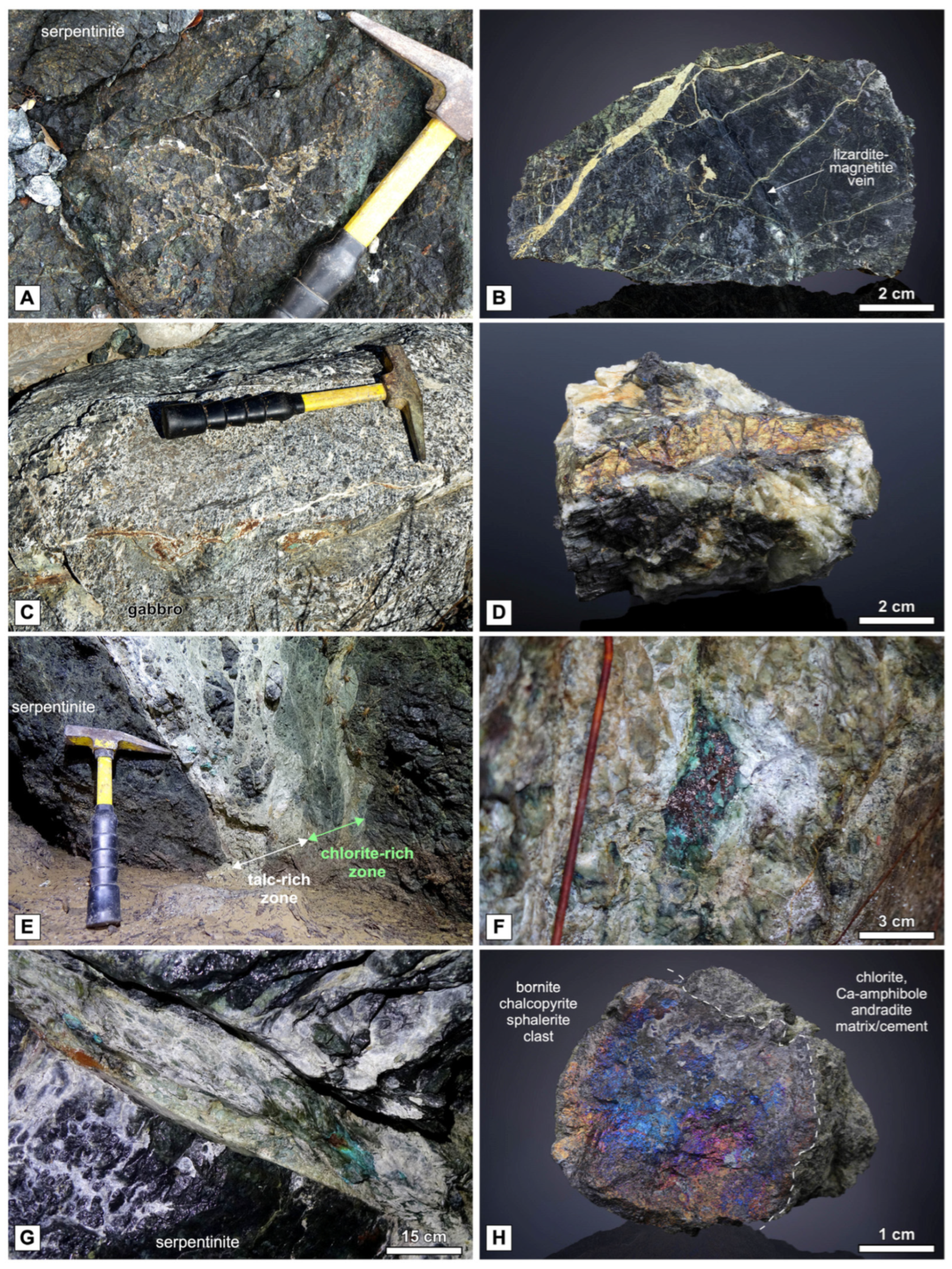

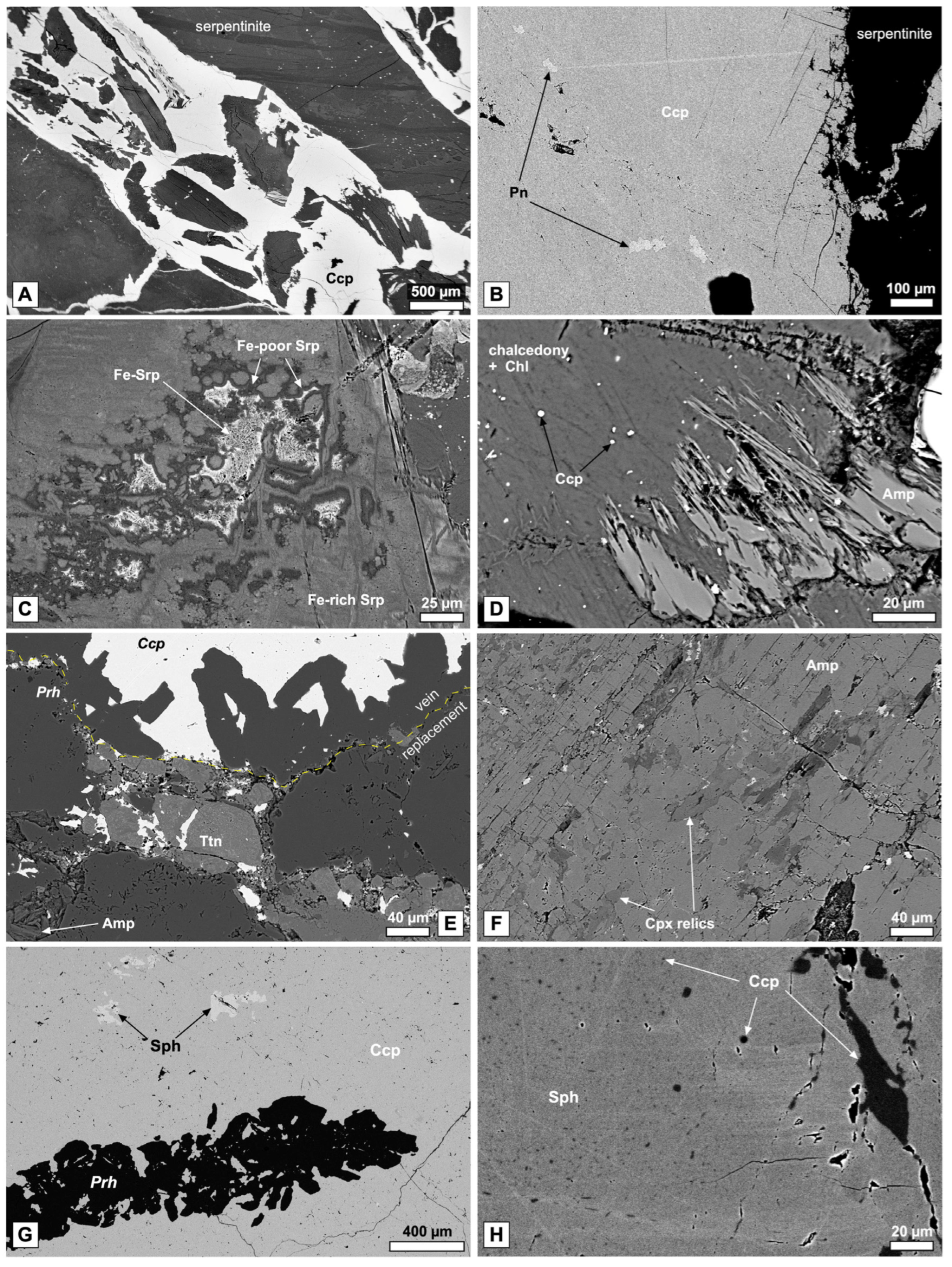



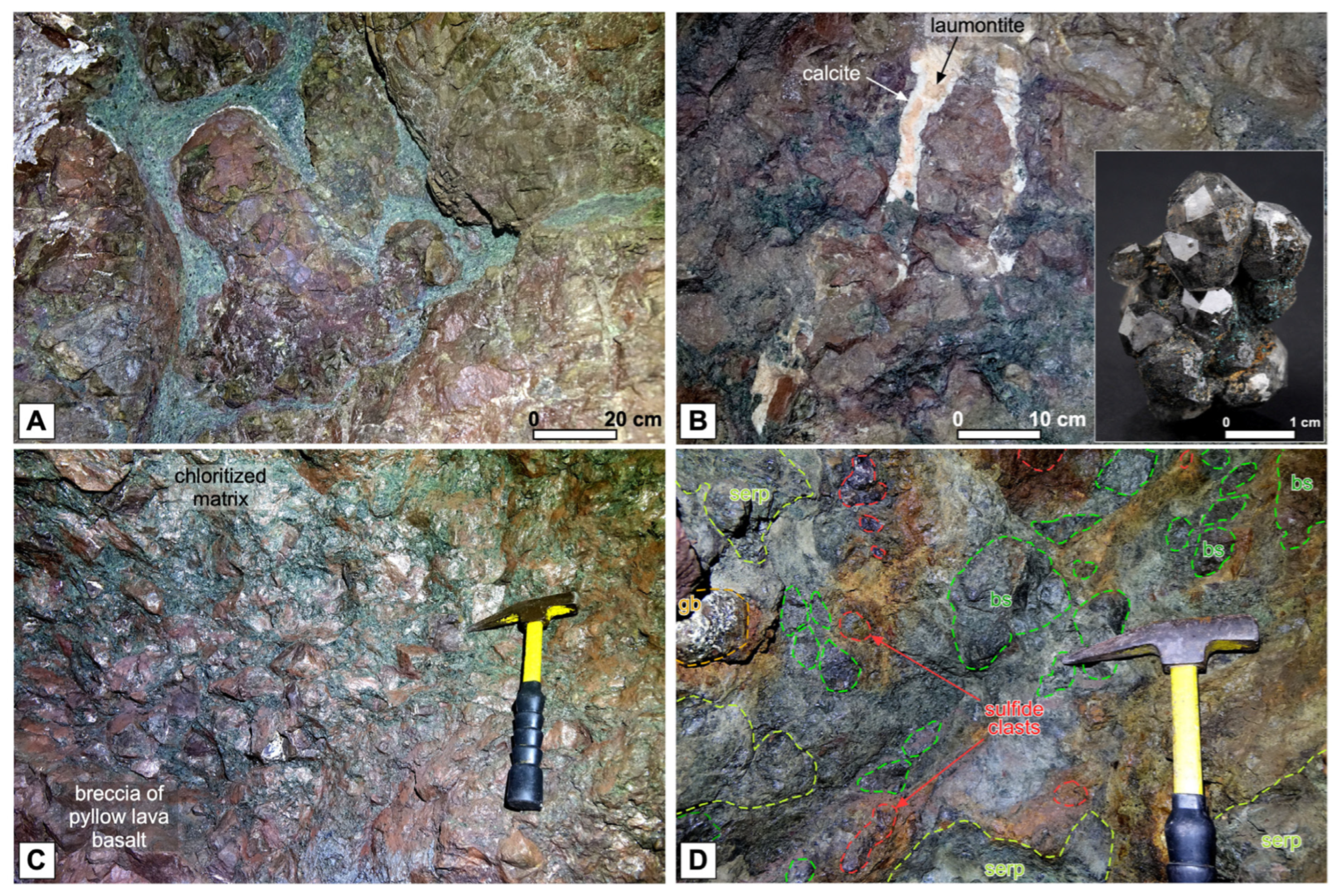
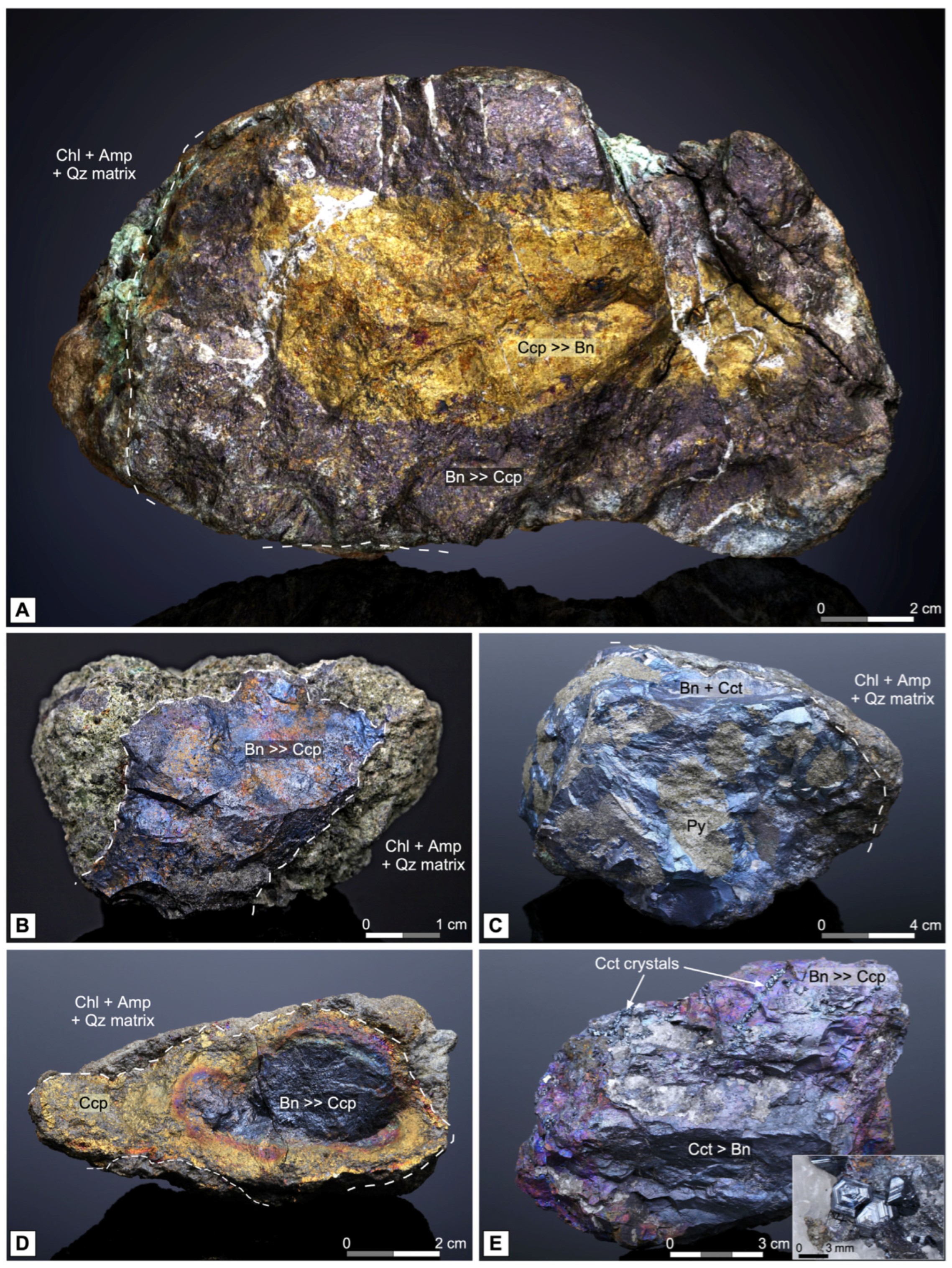
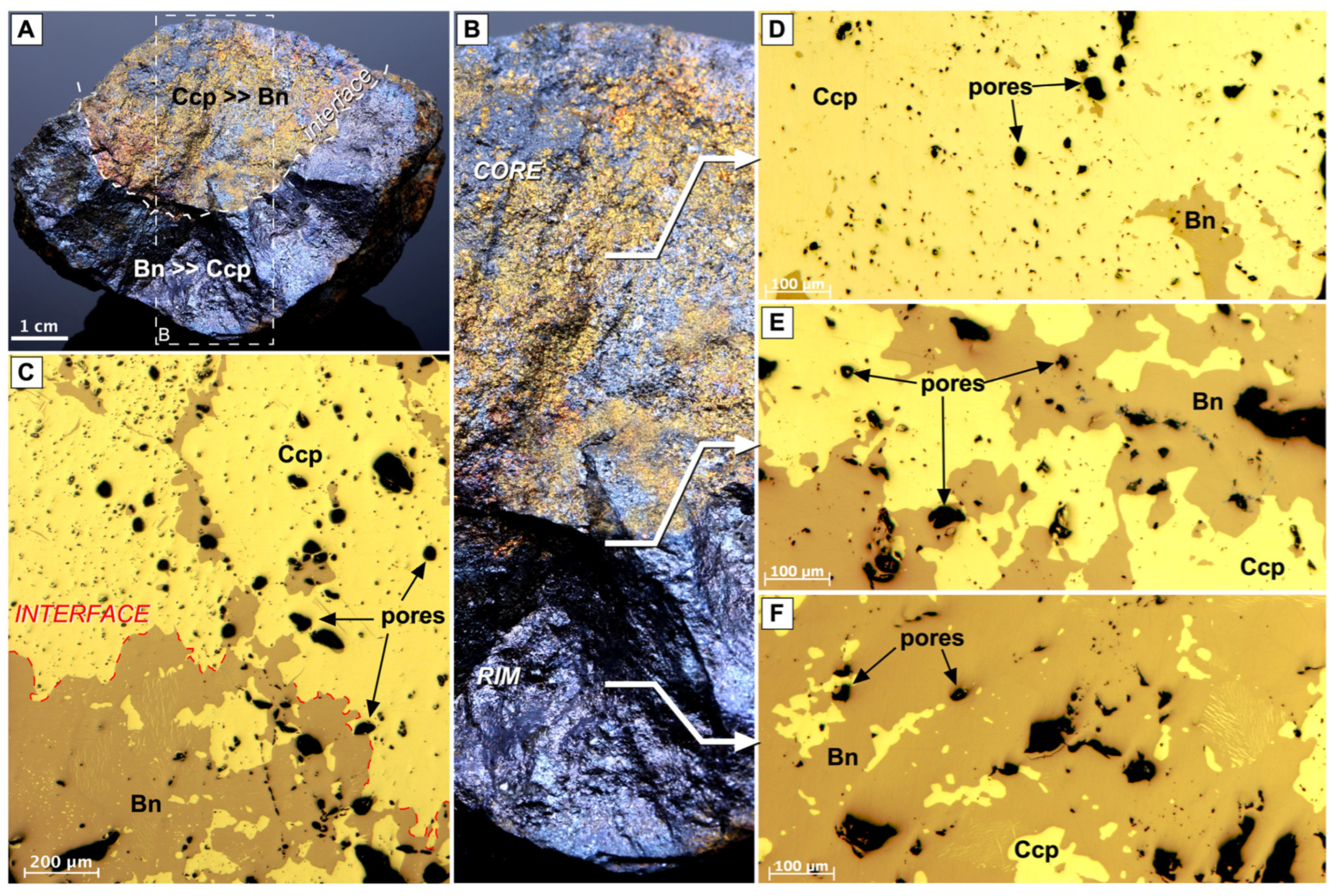

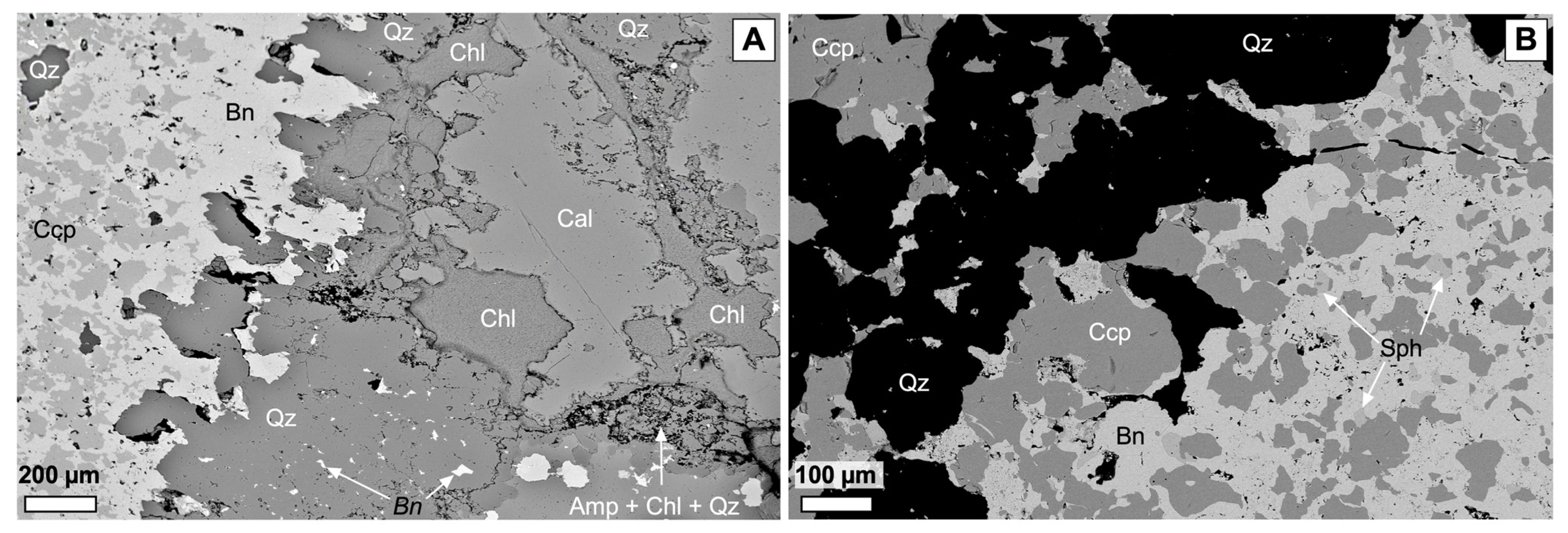
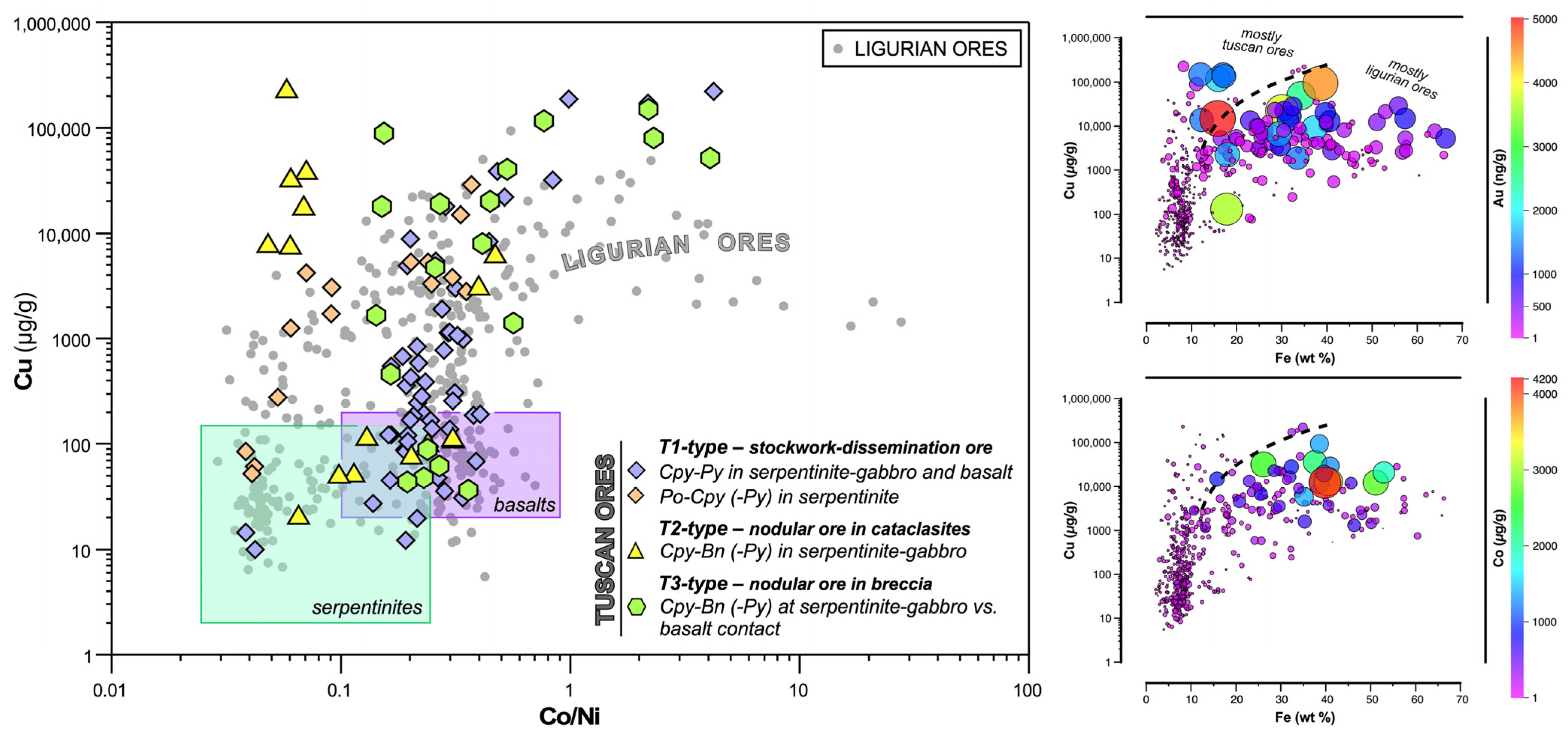
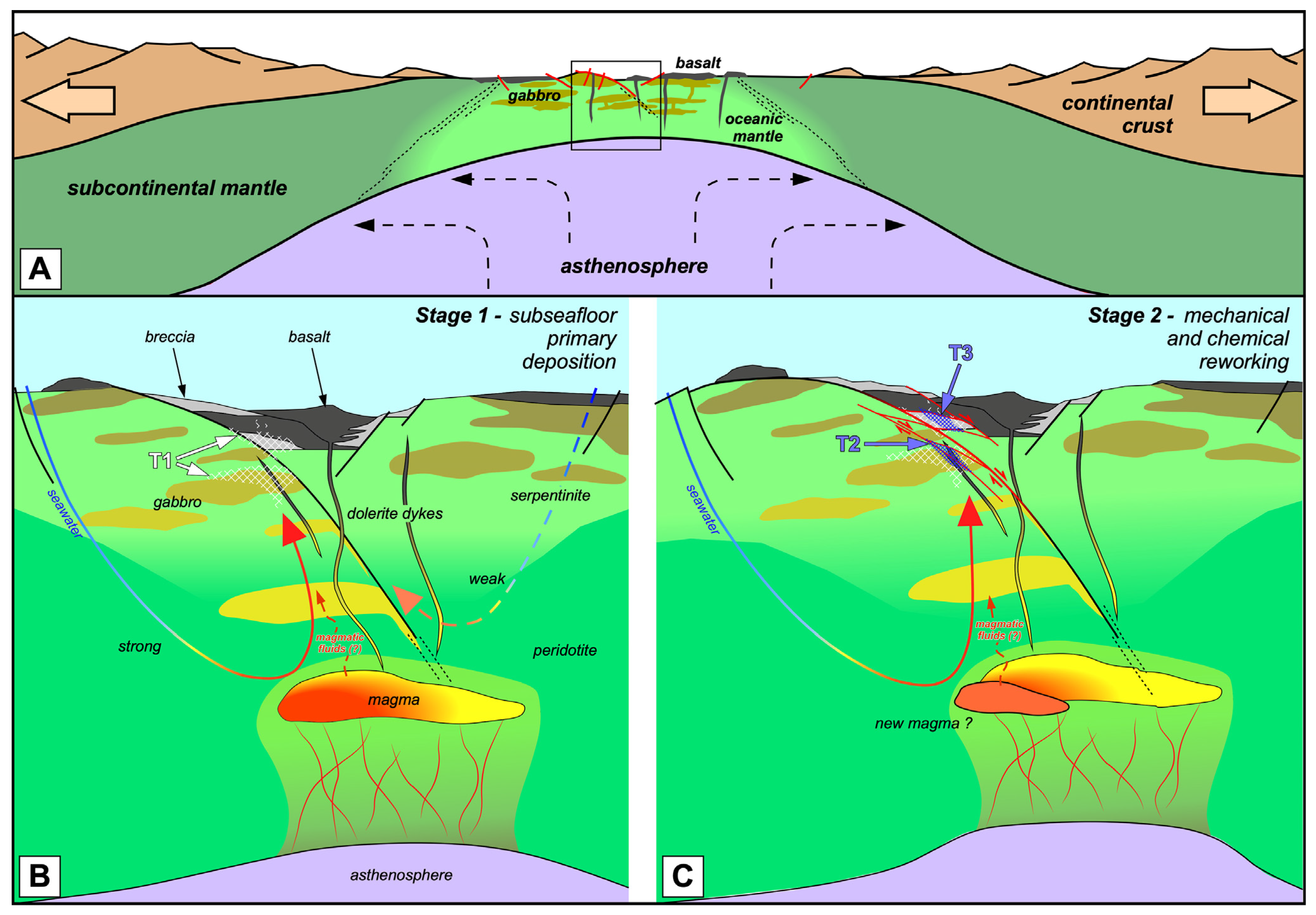
Disclaimer/Publisher’s Note: The statements, opinions and data contained in all publications are solely those of the individual author(s) and contributor(s) and not of MDPI and/or the editor(s). MDPI and/or the editor(s) disclaim responsibility for any injury to people or property resulting from any ideas, methods, instructions or products referred to in the content. |
© 2024 by the authors. Licensee MDPI, Basel, Switzerland. This article is an open access article distributed under the terms and conditions of the Creative Commons Attribution (CC BY) license (https://creativecommons.org/licenses/by/4.0/).
Share and Cite
Dini, A.; Rielli, A.; Di Giuseppe, P.; Ruggieri, G.; Boschi, C. The Ophiolite-Hosted Cu-Zn VMS Deposits of Tuscany (Italy). Minerals 2024, 14, 273. https://doi.org/10.3390/min14030273
Dini A, Rielli A, Di Giuseppe P, Ruggieri G, Boschi C. The Ophiolite-Hosted Cu-Zn VMS Deposits of Tuscany (Italy). Minerals. 2024; 14(3):273. https://doi.org/10.3390/min14030273
Chicago/Turabian StyleDini, Andrea, Andrea Rielli, Paolo Di Giuseppe, Giovanni Ruggieri, and Chiara Boschi. 2024. "The Ophiolite-Hosted Cu-Zn VMS Deposits of Tuscany (Italy)" Minerals 14, no. 3: 273. https://doi.org/10.3390/min14030273
APA StyleDini, A., Rielli, A., Di Giuseppe, P., Ruggieri, G., & Boschi, C. (2024). The Ophiolite-Hosted Cu-Zn VMS Deposits of Tuscany (Italy). Minerals, 14(3), 273. https://doi.org/10.3390/min14030273








